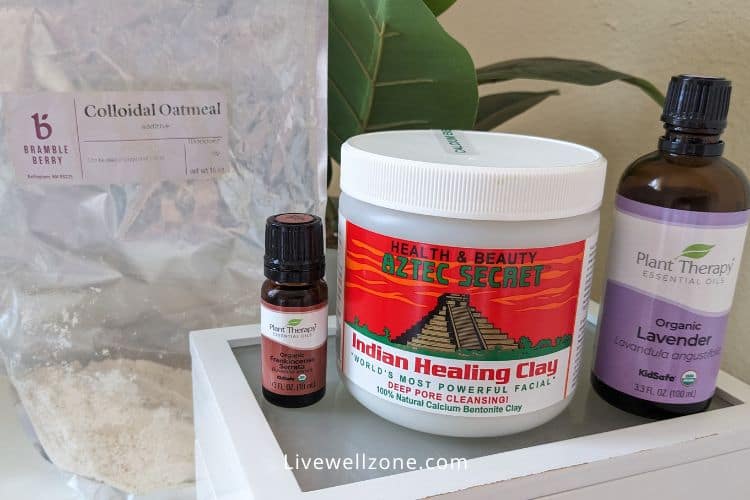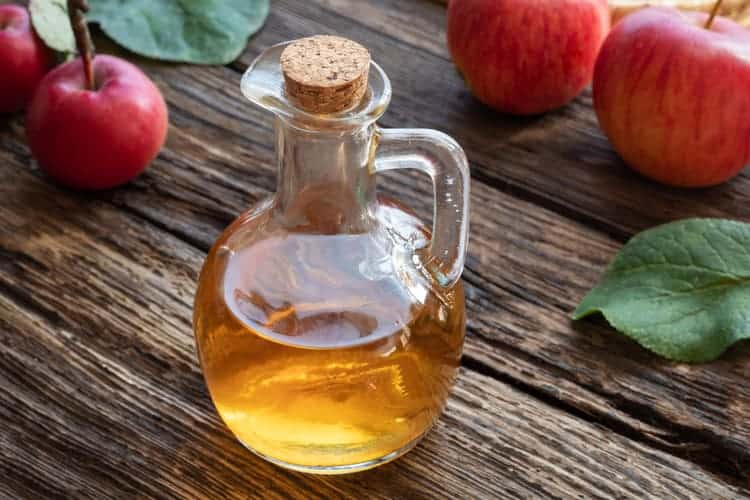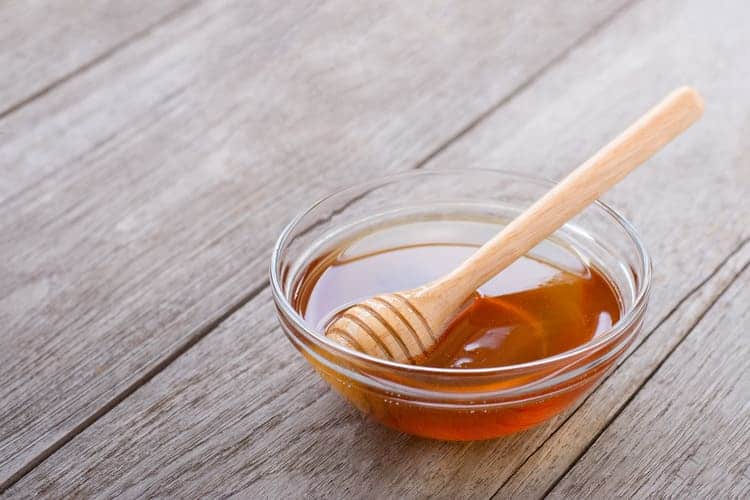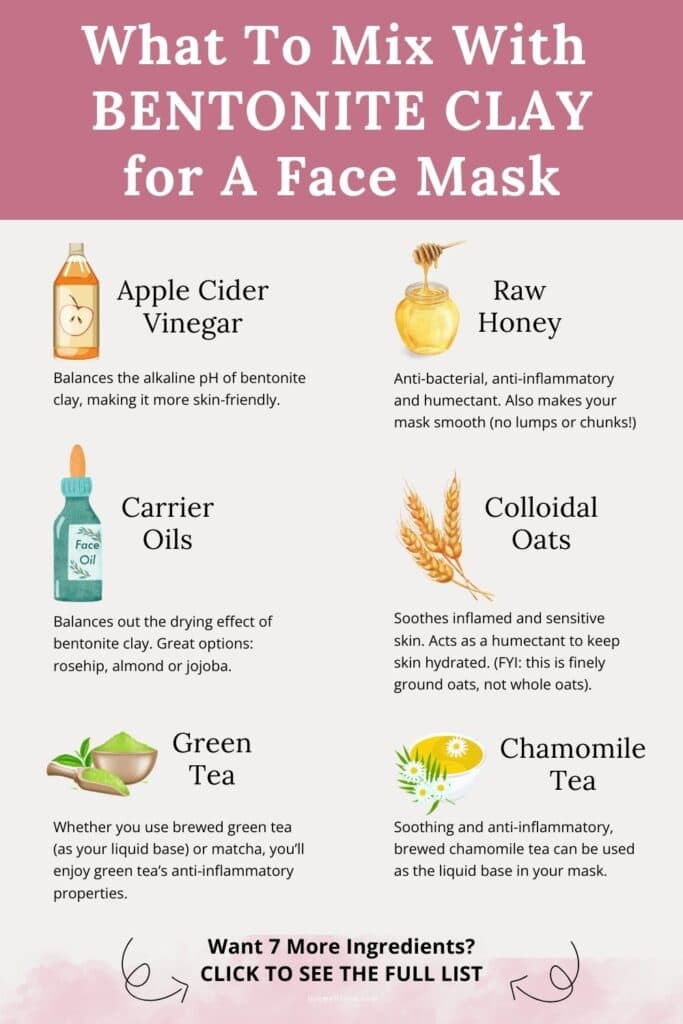
Are you brand new to bentonite clay and wondering how to use it? Or have you been using it for a while and want to know about other ingredients to up-level your face mask?
Whatever the case may be, this guide on what to mix with bentonite clay for a face mask has got you covered!
From yogurt and essential oils, to green tea and activated charcoal, this list will give you ideas for your next spa day.
Let’s get to it!
13 SKIN-LOVING INGREDIENTS TO COMBINE WITH BENTONITE CLAY FOR A FACE MASK
1. Apple Cider Vinegar

The acidity of apple cider vinegar (pH 2 – 3) balances the alkaline pH of bentonite clay (about 9 – 10)
By combining both ingredients, the resulting mask will have a pH that is closer to the skin’s natural pH of 4.7 – 5.5.
Additionally, using apple cider vinegar as your liquid base produces a mask that is less lumpy (more on that in this guide).
Lastly, apple cider vinegar has antibacterial properties and can be a very helpful home remedy for acne.
2. Water
If you’re sensitive to apple cider vinegar, then you can use water as the liquid in your bentonite clay mask.
Just keep in mind that with water, the resulting mask tends to be more lumpy.
3. Aloe Vera
Aloe vera has hydrating and anti-inflammatory properties that can make it very soothing for all skin types, especially sensitive or inflamed skin.
When using this ingredient with bentonite clay you have the option of using it in gel form or you can also use aloe vera juice.
4. Honey

Honey is a natural humectant, which means it attracts moisture to the skin, helping the skin stay hydrated.
Additionally, honey is antibacterial and anti-inflammatory, making it a helpful natural ally for acne-prone skin.
Lastly, if you want your bentonite mask to look creamy and lump-free, honey does the trick like nothing else!
5. Essential Oils
There are many skin-friendly essential oils that make a wonderful addition to any bentonite clay mask. Some to consider are:
- Tea Tree: known for its antibacterial and antifungal properties, tea tree oil is considered the best essential oil for anyone who has acne.
- Lavender: This calming oil has anti-inflammatory and antiseptic properties. Just adding a drop to your mask may help soothe irritated skin and reduce redness (while giving your mask a much more pleasant smell!).
- Frankincense, geranium and helichrysum: aside from being anti-inflammatory, these oils are said to improve the appearance of wrinkles (by the way, lavender oil is also said to help with wrinkles).
6. Rosewater
This delicately intoxicating liquid hydrates and soothes sensitive or irritated skin.
Additionally, rosewater helps maintain the skin’s pH balance and has gentle anti-inflammatory properties.
7. Yogurt
Rich in lactic acid – an alpha hydroxy acid – yogurt offers gentle exfoliation and skin-brightening properties.
In addition, the probiotics in yogurt can also help support a healthy skin barrier.
8. Carrier Oils

Whether it’s jojoba, rosehip or almond, adding a few drops of carrier oil to your mix helps make your mask less drying.
This can be especially beneficial if you have naturally dry or sensitive skin.
9. Green Tea
As a rich source of the antioxidant EGCG, green tea helps to protect the skin from environmental damage and may even help to even out uneven skin tone.
As for which type of green tea to use, you can go with brewed green tea or matcha aka green tea powder.
10. Activated Charcoal
Similar to bentonite clay, activated charcoal helps to draw out impurities from the skin.
When combined with bentonite clay, expect the resulting mask to be a potent detoxifier!
11. Turmeric Powder
Turmeric contains the compound curcumin, which is known for having anti-inflammatory and antioxidant properties.
As a result, turmeric is often added to face masks that are intended to help clear up acne or other signs of inflammation.
12. Chamomile Tea
Known for its calming, anti-inflammatory effects, chamomile tea can also be used as the liquid base for a bentonite mask.
Just make sure to let the tea cool down before mixing it with clay.
13. Oats
Oats are incredibly moisturizing and soothing for sensitive, inflamed skin.
The best way to combine oats with bentonite clay is to use colloidal oatmeal (very finely ground oats).
While you might be tempted to simply grind the oats you have in your kitchen, I don’t recommend it.
It’s really hard to obtain the powdery texture of colloidal oatmeal with a regular kitchen blender or food processor.

BENTONITE CLAY MASK RECIPES
1. Basic Bentonite and Apple Cider Vinegar Mask
Ingredients
- equal parts bentonite clay and ACV (¾ tsp – 1 tablespoon of each is enough for one application).
Instructions
- Apply the mask to freshly cleaned skin.
- Let sit for about 8 minutes (just long enough for the mask to start to dry, but not to the point where it’s cracking).
- Rinse off with warm water.
2. Bentonite and Honey Mask
For this recipe, add in ¼ tsp of honey to the basic recipe above.
Feel free to adjust the amount of honey until you reach your desired consistency (more honey results in a thinner mask).
3. Bentonite Clay Mask for Acne and Dark Spots
While the simple bentonite and ACV recipe can be used for dark spots, you can add turmeric for a little more potency.
All you need is:
- 1 tbsp ACV
- 1 tbsp bentonite clay
- 1/4 tsp turmeric powder
4. Bentonite Clay Mask for Wrinkles
Although bentonite clay is often thought of as just a “detoxifying” ingredient, it may also help improve fine lines and wrinkles (precisely because it draws out impurities that can contribute to free radical damage).
To help amplify the clay’s effect, consider adding green tea or essential oils that are known for improving wrinkles.
Ingredients
- 1 tbsp bentonite clay
- 1 tbsp brewed and cooled green tea
- 1 drop lavender, geranium or frankincense oil
FAQs ABOUT WHAT TO COMBINE WITH BENTONITE (AZTEC) CLAY
Can I mix bentonite clay with coconut oil?
Depending on your room temperature, virgin coconut oil can solidify, making it difficult to mix into a mask. A better alternative is fractionated coconut oil, which stays liquid at all temperatures.
CONCLUSION
As you can see, there’s a wide variety of ingredients that you can incorporate into your bentonite clay masks.
Whichever ones you go with, please remember that it’s always possible to experience an allergy or irritation (even with natural ingredients).
So, make sure to perform a patch test on a small area of your skin before applying the mask to your entire face.
Happy mixing!
What To Do Before and After Using A Clay Mask On Your Face: Step by Step Guide
Honey Mask vs Clay Mask: Benefits, How To Use and Recipes
Kaolin Clay Mask for Dry Skin: Benefits and Tips For A Healthy Glow

